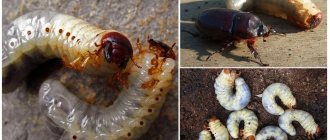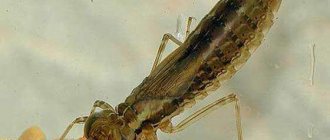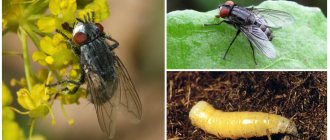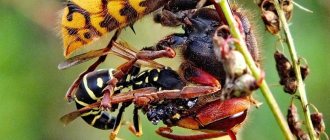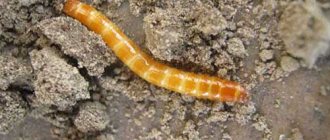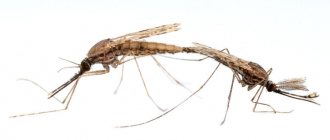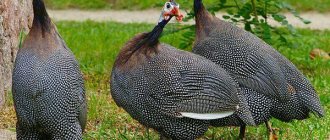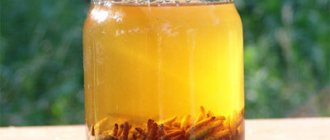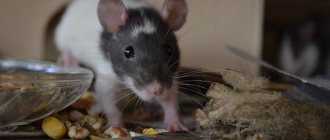Larvae
The insect larvae resemble very large mealworms, about 50-60 mm long at the last stage of development, but unlike the mealworm, the end of the body of the zofobas larvae is dark, almost black. They have 6 small legs and two vestigial hind prolegs. Once they reach the size of an adult insect, they pupate, and then large light (reddish-brown) beetles emerge from the pupae, which darken and turn black over time (24-48 hours). Larvae do not pupate if they are kept in a container with a large number of relatives and abundant food, where they are constantly in contact with each other. Containment in this manner is usually used to prevent pupation. In order for the larvae to develop into adult beetles, they must be kept separately for about 7-10 days. Then, after metamorphosis, they will emerge from the pupal stage as beetles.
Differences between beetle larvae and cabbage mole crickets
When the cockchafer larva forms, it resembles a caterpillar. It is white in color, 2 centimeters long and 8 millimeters thick. The caterpillar barrel is covered with brown dots. The back is darker than the front. And on the front there is a mouth opening and hairy small paws in the amount of 3 pairs.
The appearance of the mole cricket larva is diametrically opposite. After emergence, it is a small bug, growing larger with each subsequent molt and becoming more and more similar to an adult individual.
What to feed the larvae
Zophobas larvae: on the left - just molted, still white
Typically, the larvae are fed potatoes, apples or carrots - this is cheap and always available, and this food also provides the larvae with the necessary water. It is also common to keep them on bran or oatmeal - these products serve not only as food, but also as a substrate, in which the larvae can burrow and feel safe. Just in case, we note that for other animals (cockroaches, crickets, etc.) this method should absolutely not be used; darkling beetle larvae are the only ones that can be kept on the food substrate. Both larvae and adult beetles can consume protein sources such as dog or cat food and even dead fish, leaving behind only tough skin and bones. Does not cope well with pure fats or very fatty foods such as avocados.
Breeding
Breeding Zophobass is quite simple, but this activity takes quite a lot of time due to its relatively long life cycle. Approximate duration of development stages:
- egg: 7-10 days
- larva: 120-150 days
- chrysalis: 14-21 days
- imago: 90-120 days.
Zophobas pupa the day before hatching
The cheapest and easiest way to start a colony is to buy grown larvae at a pet store. Seating in separate single containers will ensure their pupation and transformation into beetles. Larvae that do not form a C-shape or do not pupate within 7–13 days may need food and further growth before they can pupate. Once the beetles have arrived, you can place them in some kind of container, a plastic or glass tank with a thin mesh lid or lots of small drilled holes so that they can breathe and there is no excess moisture.
You will also need to decide on a substrate, this could be oatmeal, bran or even regular soil, but it will need to be baked at around 170°C for 30 minutes as a precaution to kill off any other organisms living in it. You also need to place objects in the insectarium that the beetles can crawl onto and under. Usually they use egg cartons or other cardboard products - they are cheap enough to throw away when they get dirty.
Young beetles are reddish-brown the first day after emerging from the pupa.
Once the beetles turn from brown to black, feed them and provide them with wet food and then wait for them to mate. As soon as the male climbs onto the female and fertilizes her eggs, he gets off and she goes to lay them in the substrate or in a hard-to-reach place, for example, between two pieces of cardboard or against a wall using an ovipositor.
The process of mating and laying eggs for one pair of beetles can take several hours. After about a week, larvae will begin to hatch from the eggs, so small that they are difficult to notice in the substrate. When they're a little older, you can remove the bugs by sifting them through a colander or mesh box with holes that bugs can't get through.
The beetles will continue to produce offspring until they become too old. They will live for 3-4 months and lay eggs throughout this period (although most eggs are produced between 2-12 weeks of age). Typically, the female will lay several hundred eggs, usually around 400. Place the beetles back into the container with fresh substrate and repeat the process. Keep and raise the larvae in another container, feeding them regularly with oats or bran along with a potato or apple to keep them hydrated.
What do roundworm larvae look like?
Roundworms are considered the most common parasites that most often infect the human body. Usually infection occurs with roundworms and pinworms. The most dangerous representatives of this group are considered to be whipworm and trichinella - they can cause death.
Pinworms settle in the intestines, causing enterobiasis. Their life span is 5-6 weeks. Larvae can be found after defecation. In the stool you can see single worms or large clusters (at advanced stages). The larvae are white in color and up to 1 cm in size.
Roundworms (nematodes)
The activity of the worm begins at night - the female crawls out of the intestines and begins to lay eggs around the anus. This process is accompanied by itching.
Involuntarily, everyone begins to scratch the itchy area, thereby contributing to the spread of the parasite. Eggs cannot be seen without a microscope.
Whipworms, after entering the body, settle in the upper intestines. Their eggs are also released in the feces. The worms' appearance is distinguished by their thin, hair-like body shape.
Roundworms are distinguished by their red-yellow color and spindle-shaped shape. The danger of the parasite lies in the ability of the larvae to migrate throughout the body, causing serious complications.
Roundworm larva
In just one day, a female roundworm lays approximately 200,000 eggs.
As a food item
Exuvium (empty skin) of a molted larva
Zophobas larvae are readily eaten by lizards, turtles, frogs, salamanders and newts, birds, koi carps and other insectivorous animals, as well as ants. Their tendency to bite with their strong mandibles can be dangerous to pets, but this can be avoided by crushing the head. Their nutritional value is similar to mealworms, so it is possible that calcium supplementation will be required if they are used as a primary feed. In some cases, zofobas larvae are preferred over mealworms due to their soft exoskeleton, making them more easily digestible for some reptiles. In adult beetles, a caustic chemical defense - a white liquid - can be released from the gland behind the head, which is used if they are disturbed, so pets are not fed adult insects. Larvae, on the other hand, are odorless and easy to keep, making them ideal for raising at home as food for a collection of insectivorous pets. Most of these insects raised in captivity are intended specifically for feeding animals. Nutritional value of Zophobas morio:
- 46.80% proteins,
- 43.64% fat,
- 8.17% ash
- 1.39% carbohydrates.
“Cyborg beetles”: on the left - Zophobas, on the right - Mecynorhina torquata from the group of bronze beetles. Photo from "Biological Machine Laboratory", Nanyang Technological University, Singapore
A 2012 study found that the insect could also be used as a partial fishmeal replacement for farmed tilapia fish.
Useful tips
If you give zofobas larvae as a treat, either feed them to your pet with tweezers, or place them in a feeder or bowl from which they cannot escape. They are excellent burrowers, and it will be difficult or even impossible for your pet to find them if they burrow. It will be useful to sprinkle such food with a high-quality vitamin and mineral supplement.
Zophobas has a really hard chitinous exoskeleton, which makes digestion a little difficult, so do not feed your pet them too often: the ideal option is several larvae at a time, 2-3 times a week.
Pairing
Despite the fact that zofobas larvae are very similar to mealworms, never refrigerate them - they will quickly die from this (in nature they live in the hot tropics). Should be kept at a temperature of 21–27 °C. They can be kept without food for 1–2 weeks.
Best kept in a smooth plastic container. If you move the adult beetles into new containers every 1-2 weeks, the larvae that hatch in the container will be the same age and size, making feeding easier.
To isolate the larvae from each other for pupation, you can use plastic boxes with separate sections, like those that are usually used to store beads, fishing tackle and other small items. About a week after isolation, the larvae will begin to curl into a “C” shape and then pupate. The pupae will darken, and after 2-3 weeks the adult beetles will hatch.
Feeding insects for... people: stand with food made from Zophobas larvae at the Foodparade festival at Troja Palace, Prague, 2015.
After the eggs hatch (7-10 days), you will see small white larvae. Treat them the same way as large ones, and after 3-4 months you will have larvae 4-5 cm long. You can already feed them to your pets, but do not forget that some must be left for the next generation to appear.
If a beetle's elytra are damaged, this is not dangerous if it does not interfere with its movement. The elytra are not a vital organ; they protect the insect's abdomen from mechanical damage.
How to attach a cockchafer larva to a hook
For bait, hooks No. 10-12 with a long shank are best suited. In principle, hooks for maggots are suitable. The larva is inserted so that the sting first pierces the area below the head, and passes through the body and comes out just above the tail. When catching large specimens, the head and tail can be removed.
The figure shows how to properly install the larva:
You can put several larvae on the hook. You will get a volumetric nozzle of this type:
This delicacy will appeal to bream, carp and large silver bream with roach. You can use a bottom rig with a fairly large hook. Small fish will not covet such food and bites will be rare, but large fish will. Load up several donks or feeders with these baits and start fishing slowly and steadily. This format of fishing for large fish is liked by many bottom fishers and feeders. Fishing takes place without fuss, unnecessary movements and without frequent casts.
